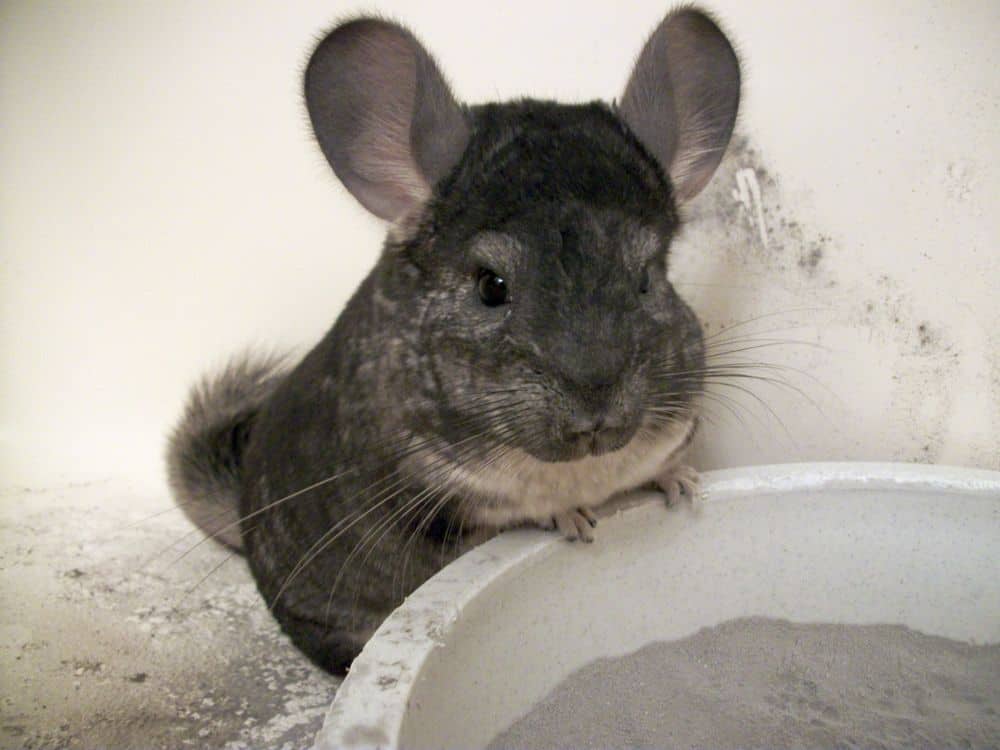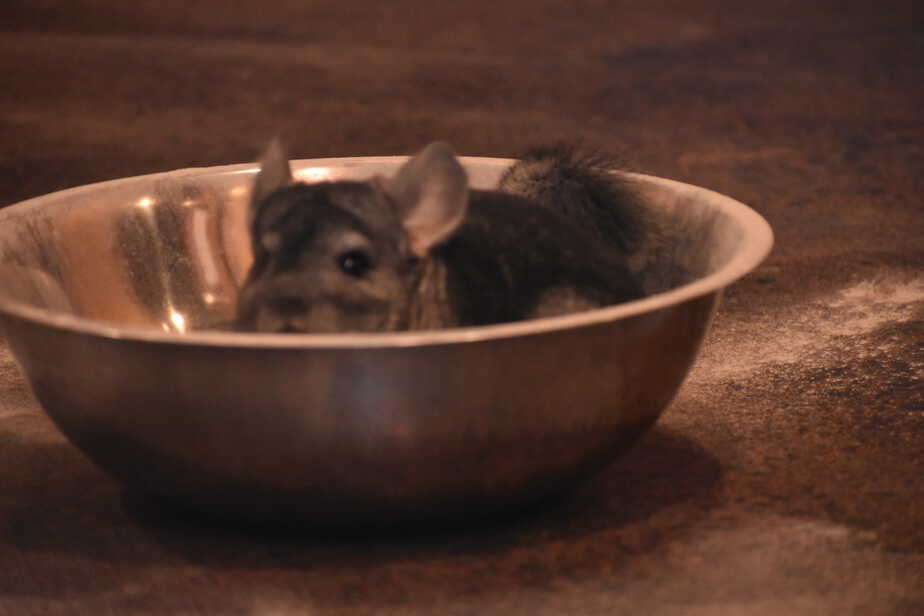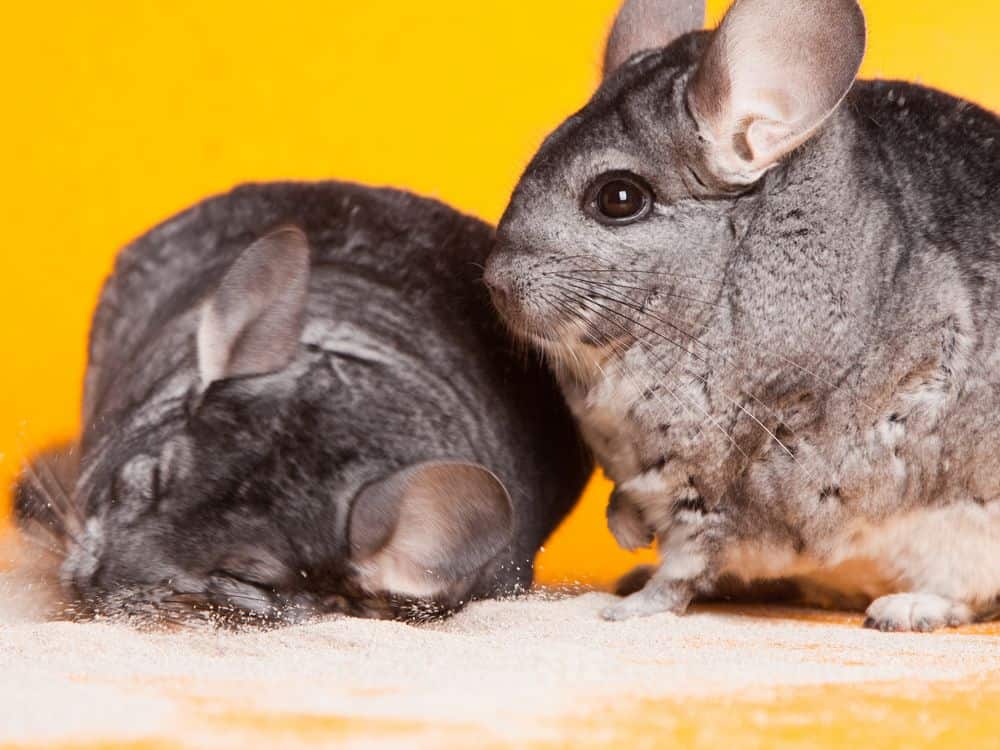
Maybe you’re read somewhere that water kills chinchillas.
Not true. But it is true that they should not get wet.
Maybe you’ve read something about bathing in dust.
That is true, strange as it sounds.
That is how chinchillas bathe in the wild. And it is how they should continue to bathe in captivity.
Keep reading to learn exactly how chinchillas bathe and what you need to do you need to do to help your pet stay clean.
The nice thing is that they do most of the work. You mostly just have to watch, which is pretty entertaining!
Contents
- 1 How Do Chinchillas Bathe?
- 2 How Chinchillas Bathe: Final Thoughts
How Do Chinchillas Bathe?
Chinchillas bathe in dust, not water. That may not sound clean to us, but it is. Chinchillas are exceptionally clean animals. Unlike dogs, they do not need you to bathe them and are capable of cleaning themselves.
But they do not like water and getting wet stresses them out. It can also be dangerous. More on that below.
These rodents need special chinchilla dust baths to stay clean (that article has a video of my chin bathing, which is definitely worth watching).
The dust they use is made of clay or volcanic ash. It eliminates moisture, oil, parasites, and debris from the chinchilla’s coat, leaving it healthy and clean.

Chinchillas are not alone in this. Other animals, like gerbils and degus, also require dust baths to bathe. As an owner of one of these animals, you need to provide your pet with bathing dust (made especially for Chinchillas) for it to roll in. Chinchillas need a dust bath at least twice a week.
Some people leave the dust bowl in your chinchilla’s cage, but it is much better to take your pet out of the cage for its bath. It makes clean up easier, for one.
Baths should last about 15 minutes at a time, or long enough for your pet to completely cover itself in the dust. Your pet will shake off the excess once it is completely covered in dust.
We have a complete step-by-step guide on how to give your chinchilla a dust bath.
How Dust Baths Help Chinchillas
Chinchilla dust bath powder is made of special clay or volcanic ash. This substance is hygroscopic and absorbs excess moisture and oils (and with it, the trapped debris) from your chinchilla’s fur. This leaves your chinchilla’s coat nice and clean.
Chinchillas are native to the Andes Mountains of South America. In their natural habitat, they use volcanic dust found in the mountainous terrain to keep themselves clean.
They roll around and play in it and that keeps their fur clean and free from oils and moisture. Removing excess moisture trapped in the chinchilla’s fur is especially important to prevent mold and other fungal skin infections in your pet.
Moreover, rolling around in the dust is essential for your chinchilla’s mental well-being. Dust baths provide chinchillas with stress relief and help them relax.
Therefore, you must provide your pet with bi-weekly dust baths so it can maintain its skin hygiene, remain clean and healthy, and also stay calm and happy.
Can’t You Just Leave A Dust Bath Bowl In The Cage Permanently?

Some chinchilla owners allow their chin a 15 to 20 minute dus bath outside the cage, while others choose to leave the dust bowl permanently in their pet’s cage.
Leaving the dust bowl in the cage permanently allows your pet to bathe whenever it wants to. However, it is generally better to not leave a dust bath in the cage permanently. Here are the main reasons for that.
- You can reuse the dust (if it is clean) and provide your pet with the same dust again after a few days.
- The dust tends to mess up the cage when your pet frolics around in it. Giving your pet its bath outside the cage (I do it in the playpen) bath helps keep the cage cleaner.
- Some chinchillas will defecate or urinate in the dust bowl and use then continue to use it as a toilet. This is the primary reason I always recommend giving dust baths outside the cage.
- Excess dust bathing can dry your pet’s fur.
What Kind of Dust Bowl Should You Use?
There are special chinchilla dust bath houses available in the market. These are the easiest and best options, but you can always make a simple DIY bath for your pet using a sturdy bowl you have at home.
Ensure that the bowl is made of wood or non-toxic, food-grade material. Chinchillas chew up everything and the last thing you want is your pet chewing up plastic or other toxic materials.
For that reason, wooden bowls are the best. But make sure the woods is not toxic for chinchillas. The bowl you choose should be roomy and spacious for your chinchilla.
Make sure to clean the dust bowl every now and then. You can use mild soap or detergent for this purpose. Dry the dust bowl completely before filling it up with dust otherwise, it might form clumps on the bottom of the bowl.
What Kind Of Dust Should You Use?

You can use commercially available chinchilla dust which is usually made of volcanic lava ash, rocks, minerals, and volcanic glass.
Some chinchilla dust brands use powdered pumice. The downside of pumice dust is that it can be harmful to humans. It can irritate human lungs and trigger allergy symptoms.
Some chinchilla owners provide sand baths to their pets, but we do not recommend them because they do not clean your chinchilla’s fur as effectively as volcanic ash can.
Zeolite dust is another option – it is especially suitable for chinchilla parents that are allergic to regular chinchilla dust. We have an article recommending the best chinchilla dust here.
How Often Should You Replace The Dust?
Most dust manufacturers provide clear instructions as to how often to replace the dust. If there are no instructions, you can simply replace it after each use, or when it has become clumpy and moist.
Be sure to keep the dust away from your chinchilla’s water bowls, because water makes the dust clumpy and clumpy dust cannot clean your chinchilla’s fur efficiently.
If your chinchilla has pooped or peed in the dust, it should go without saying that you should replace it promptly.
Do Dust Baths Actually Clean Chinchillas?

Yes. Dust baths are very efficient at keeping your chinchilla clean. In their natural habitat, chins use volcanic dust that is naturally present in their environment, to keep themselves clean.
Specially made chinchilla dust absorbs the excess oils and moisture in its fur. When your pet shakes off the dust after rolling in it, trapped debris, parasites, and moisture are shaken off with it. This leaves your pet’s fur soft and clean, and it ensures no fungus can take hold.
Other rodents actually do the same thing. But using chinchilla dust for gerbils, for example, is not ideal. Better to use dust or sand made specifically for each species.
What Happens If A Chinchilla Gets Wet?
Chinchillas live in a dry, arid environment and are not supposed to get wet. Water can remain trapped under their fur and, if not dried properly, could increase the risk of fungal skin infections.
Worse, if your chinchilla remains wet for a long time, it is at risk of developing hypothermia and might even die.
Chinchillas do not bathe in water and they do not swim. In their natural habitat, if they fall into a water body, they immediately try to get out of it. They certainly are not natural-born swimmers.
Also, their natural habitat does not have many water bodies in the first place, which protects them from getting wet in the wild.
In captivity, you should not use water to give your chinchilla a bath either. Instead, provide your pet with a dust bath as described above.
On rare occasions, and particularly if your pet has rolled into something offensive or sticky (such as dirt, paint, or oil), you may use a damp cloth to wipe its fur. Do make sure to dry its fur immediately after wiping. We have an article explaining how you can dry your wet chinchilla.
How Chinchillas Bathe: Final Thoughts
Chinchillas bathe in dust, not water. Their dense fur does not dry easily. Moisture can get trapped inside and cause all kinds of issues that can even lead to death.
While bathing in dust does not sound especially hygienic, it actually works incredibly well to keep these rodents clean. The key is to make sure you provide the right dust and set up the bath correctly. If you followed the links above to the corresponding articles, you should have no problems at all.
Leave a Reply